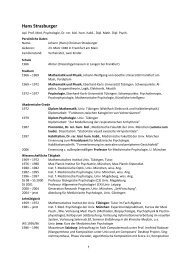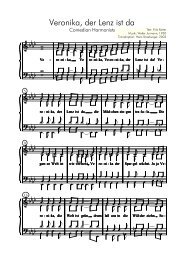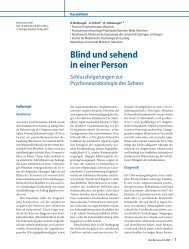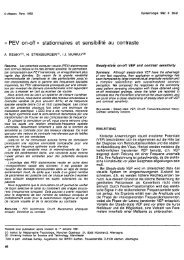Peripheral vision and pattern recognition: a review - strasburger - main
Peripheral vision and pattern recognition: a review - strasburger - main
Peripheral vision and pattern recognition: a review - strasburger - main
Create successful ePaper yourself
Turn your PDF publications into a flip-book with our unique Google optimized e-Paper software.
<strong>Peripheral</strong>_Vision.doc<br />
a<br />
b<br />
9° 14.5° 22°<br />
Figure 2. (a) The perimeter built by Hermann Aubert <strong>and</strong> Carl Foerster in Breslau in 1855 to<br />
measure letter acuity in dark adaptation. “We had digits <strong>and</strong> letters printed on 2 feet wide <strong>and</strong> 5<br />
feet long paper at equal distances. That paper sheet could be scrolled by two cylinders, such that<br />
new characters could always be brought into the visual field. The frame was adjustable between<br />
0.1 <strong>and</strong> 1m viewing distance ...” (Aubert & Foerster, 1857). The use of an electric arc (“Riesssche<br />
Flasche”) for brief presentation dates back to Volkmann <strong>and</strong> Ernst Heinrich Weber. (b) Aubert <strong>and</strong><br />
Foerster’s (1857) results for photopic two-point resolution (measured with a different apparatus).<br />
The inner circle corresponds to 9° visual angle; measurements go out to 22°. Note the linear<br />
increase up to 14.5° radius, <strong>and</strong> steeper increase further out.<br />
Aubert <strong>and</strong> Foerster’s measurements of letter acuity demonstrated that, up to the blind spot, the<br />
minimum discernible size is essentially proportional to the maximum eccentricity angle.<br />
Minimum size increases (i.e. acuity decreases) at a steeper rate farther out. They also<br />
described the isopters (lines of equal acuity) as being elliptic rather than circular in shape, with<br />
the <strong>main</strong> axis along the horizontal meridian. For a more detailed description of the isopters they<br />
performed a second experiment in which they measured with a different apparatus two-point<br />
separation under photopic conditions with unlimited viewing time. Here, the subjects were<br />
trained to fixate well. The <strong>pattern</strong> of results was more complex, showing a nasal/temporal<br />
anisotropy <strong>and</strong> considerable interindividual variation, but on the whole, the first experiment was<br />
confirmed.<br />
These results are well known. What is less well known is Aubert <strong>and</strong> Foerster’s insight that<br />
peripheral <strong>vision</strong> seems to be qualitatively different from foveal <strong>vision</strong> in some rather strange<br />
way:<br />
“When the two points cease to be distinguished as two, that is when they lie beyond the limiting<br />
point, they are not seen as a single point but quite peculiarly undetermined as something black, the<br />
form of which cannot be further stated. Also on the skin, in those bluntly sensing areas, two<br />
dividers’ points never make qualitatively quite the same impression like a single dividers’ point. …<br />
6






